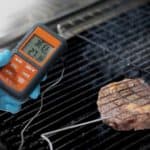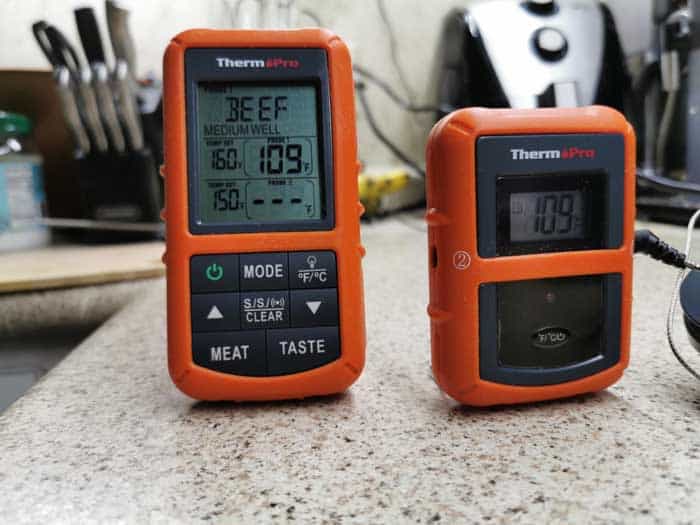Got your brand new grill thermometer but not sure how to use it? Luckily, with good care and proper use it couldn’t be easier. Here’s how to use an instant-read thermometer.

- Why You Need an Instant-Read Thermometer
- How to Know When Food is Done
- Don't Use 'the Fingertip' Method
- How to Use an Instant Read Thermometer
- How to Use Your Thermometer for Measuring Meat Temperature
- How to Use Your Thermometer for Reading Grill Surface Temperature
- How to Keep Your Thermometer Clean
- Calibration
- Can You Leave a Meat Thermometer in the Meat While It's Cooking?
You can have the best backyard grill but if you don’t use it properly, you might as well be cooking over an open fire.
Personally, there are a couple of tools I couldn’t do without to ensure my grilling is to the best possible standard. One is high-quality coals (not briquettes!), while the other is a reliable and durable grill thermometer.
Many experts claim that simply feeling meat is enough to gauge ‘doneness’, based on the meat’s firmness, texture, and resistance.
I have a big problem with this.
Meat safety is all about knowing exactly when it has hit the right temperature. Is this something you really want to leave to guesswork?
This kind of arbitrary guesswork can easily be misjudged and can ruin your meat, or even be dangerous.
This is exactly why health organizations worldwide urge you to use a meat thermometer, and who are we to argue with them?

The USDA even launched a campaign, called ‘Is It Done Yet?‘ to promote thermometer use when judging when food is ready.
In this article, I’ll be citing their research, showing you exactly how to use and take care of your instant-read digital meat thermometer
Why You Need an Instant-Read Thermometer
Food safety is obviously important, but using a good thermometer goes beyond this. It ensures your meat tastes as delicious as possible. What’s the point of spending hours buying meat, food preparation, grilling or smoking, only to then ruin it by under or overcooking it?
Also, while your stomach can stand up to certain germs from meat, the same isn’t true for pregnant women, the elderly, or children. Making sure that everyone can eat your food should always take priority.
If you can’t take our word for it, I recommend looking at this page on food-borne illnesses. It lists the kinds of food illnesses that can emerge from poorly prepared meat.

How to Know When Food is Done
Different kinds of meat need to reach specific temperatures before the ecoli in the flesh is killed off. Failure to do this can cause fatal problems, so it is imperative to understand these temperature benchmarks.
In general, the rule is around 160°F (71°C), but this does change for different cuts of meat. Medium-done beef can actually be eaten at around 140°F (60°C), while ground poultry actually needs to be closer to 165°F (75°C).
Check out this quick guide on target meat temperatures to help you get a better understanding of target meat temperatures.
Don’t Use ‘the Fingertip’ Method
Many people swear by comparing the firmness of meat to their own hands as a guide for when meat is cooked. While this may offer a good feel of firmness, it can’t accurately gauge its internal temperature.
The purpose of a thermometer is in essence to let you know if the bacteria in the meat has died. The fingertip method can’t ever do this.
Knowing the internal temperature of meat is the best way to know when it’s safe to eat meat, and using a meat thermometer is the only way to know this.
How to Use an Instant Read Thermometer
Luckily instant read thermometers are on hand to offer a quick and easy way to finding out when your food is done. What can make things confusing is that there a lot of different types out there.
Personally, I would always recommend going for a dual probe model. This type of thermometer has one probe for reading the internal temperature of your meat, and another for reading the surface temperature of your grill.
Why is this important? Ultimately the key reading is obviously your meat, as we need to know when it hits that all important 160°F mark. But for the purposes of cooking it’s also important to gauge the ambient cooking temperature of your grill. You wouldn’t blindly turn on your oven without checking the temperature it’s set to, and the same goes for your grill.
How to Use Your Thermometer for Measuring Meat Temperature
The key with a meat probe is always to ensure that it’s inserted into the thickest part of the meat. This will ensure that you get a reading on the part of the meat that is most likely to be undercooked. If the reading for this part comes back good, then you’re all set to serve up.
Timing is also key here. Meat tends to continue cooking for a little while after it’s removed from the grill, oven or smoker. So your best bet is to get a reading near to the end of its cooking time, not at the end. Personally, I always leave my meat probe in throughout cooking, but not everyone has this luxury.
While the vast majority of outdoor grills and smokers provide even cooking, hot spots can appear across the cooking surface (particularly with charcoal grills). To combat this, take a reading across multiple points in your meat: One from where the meat is thickest, and another from further away. This should make it easier to compensate should your meat be cooked faster in different places.
If you are cooking flat or thin cuts of meat, like burgers, instead of inserting your probe from the top, insert it from the side.
Make sure that you don’t allow the probe to touch any bone. This will give a useless reading, potentially one that’s much higher than the meat’s real reading due to the heat conductivity of bone.
How long it takes to get a reading is likely to depend on what kind of instant-read thermometer you have. Generally speaking, they fall into two categories: Dial and digital.
If you have a dial thermometer, then it will take about 15-20 seconds for you to get a reading. If you have a digital then it should only take about 10 seconds.
Also, at this point I want to say that digital thermometers are far more likely to give a more accurate reading than dial, so if you don’t have a digital model then I recommend considering upgrading. You won’t regret it.
How to Use Your Thermometer for Reading Grill Surface Temperature
How you set up your thermometer for reading ambient grill heat levels will also depend on what kind of thermometer you have.
If you have a dial thermometer, then your best bet will be to install it on the lid of your grill. I have written a guide on this before, so be sure to check out my guide on how to install a grill thermometer.
If you have a digital probe, then simply place the probe on the grill grates, with the probe either facing downwards into the drum, or upwards (if you can get it to balance). The most important thing is not to have it placed directly above your flames, as this will give a much higher reading than the actual ambient temperature of your grill.
How to Keep Your Thermometer Clean
Like with anything that comes into contact with raw meat, it’s important to clean your thermometer probe after every use.
Luckily, these little beauties are really quick and easy to clean.
When you first get yours out the box, wash the probe down with hot soapy water before your first use. Just be careful if your thermometer isn’t waterproof. You don’t want to get any water in the main reader compartment of the device.
Always wash between uses. This will prevent germs from developing across the meat’s surface and in any crevices.
Calibration
Frequent recalibration helps keep your thermometer accurate. Thermometers can lose accuracy after long-term use or if exposed to different temperature extremes in a short space of time.
The vast majority of digital thermometers are self-calibrating, but if you suspect that your reading might be off then you can quickly recalibrate it using the boiling water method.
Simply place the thermometer probe in boiling water and check the temperature reading. It should be 212°F (100°C). If it isn’t, then you will have to tweak the settings on your thermometer.
Can You Leave a Meat Thermometer in the Meat While It’s Cooking?
For me the answer to this comes down to what type of thermometer you have.
If you have a simple one probe model with the main body of the device built all in one, then no. Exposing the body of the thermometer to high heats will degrade it, and even risk breaking it.
However if you have a model which has a probe either connected to the main body of the thermometer either by a long wire or wireless connection, then you can leave it in the thermometer.
I have an Ivation wireless thermometer that does exactly what, and it allows me to keep a close eye on the progress of both my meat and grill’s ambient temperature at all times.







